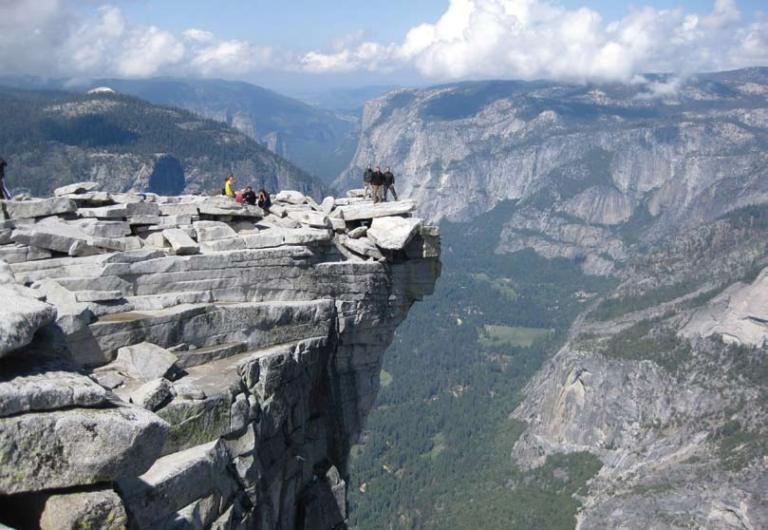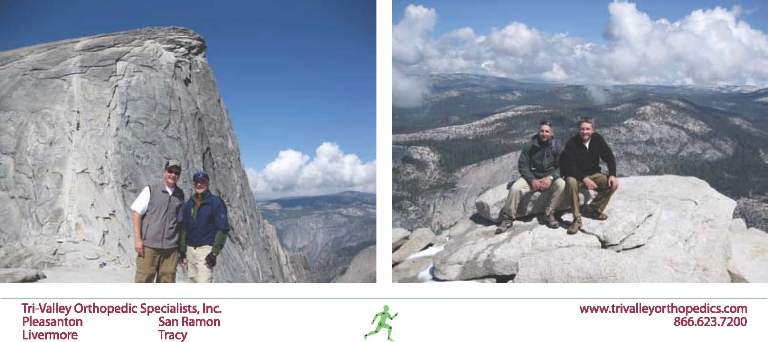If you’re an avid hiker, at some point you’ve probably thought about tackling Half Dome, Yosemite’s iconic, almost-mile-high peak. As our recent experience testifies, it can be the perfect adventure—strenuous but not out of reach for outdoor fans in good physical shape. However, climbing Half Dome—or a similar endurance event (our ascent took about 12 hours round trip from the trail head parking lot)–is not one of those left-tochance activities that suddenly looms on next week’s calendar. The intense physical effort, in tandem with the changeable natural environment, introduces an extra layer of risk that demands respect. Advance planning is the only way to have confidence in a safe, enjoyable outcome.
We were fortunate to have the guidance, and the company, of a physician colleague who was a veteran of several Half Dome summits. We scheduled our three-man expedition for a Thursday at the end of May, to minimize both weather and crowd issues. The timing gave us more than two months to gear up, literally and figuratively. Our concerns ranged from physical training and adequate nutrition to choosing the right clothing and supplies. Our training regimen was the longest-term consideration. While both fit, we were at different levels of conditioning. Roger, who has been working out for over 30 years, uses free weights regularly and gets in half an hour of cardio training three times a week. Dave started going to the gym more often for sessions on the stairmaster and elliptical cross-trainer to build up strength and endurance. We both tried to squeeze in more aerobic exercise— carrying our clubs on the golf course, walking and biking, hiking up Pleasanton Ridge.
Footwear is something else to think about early on. You need to make sure your feet are used to the shoes you’ll be wearing, so if buying a new pair, break them in with short walks or lesser climbs over a period of

several weeks. Hiking boots made of GORETEX® are waterproof and breathable, and they’re lightweight for greater comfort. “Mid-tops,” which come up just over the ankle, provide support without being overly restrictive. Choose socks wisely, too. The high-performance “SmartWool” brand naturally regulates foot temperature, wicking away perspiration and helping to avoid blisters, which can be really detrimental on a climb.
The California standard of dressing in layers also applies to hiking. The difference is the new breed of active wear made out of synthetic materials that manage moisture (even better than cotton) so you stay dry and comfortable. Make sure you can shed or add pieces as you progress. A close-fitting shirt of the new treated polyester fabric absorbs perspiration more quickly than a loose one. A wool beanie keeps the head warm in the cold and damp of an early morning start. Rain gear affords protection on wet trails, especially around the overspray from the seasonal waterfalls.
During the climb the paramount concern is staying hydrated. Neophytes hear this warning over and over: don’t wait to get thirsty before you start drinking. Fluid levels are already depleted by the time you feel thirst. At our rapid pace, we knew our bodies would be losing a lot of water, and we couldn’t pack in enough to meet our needs. By bringing along a lightweight, battery-powered UV purifier, we successfully treated water from local streams so we could always resupply. Using a hydration pack, the collapsible plastic bladder with an attached sipping hose, made it easy to drink frequently along the way.
As for nutrition, we made sure to eat a high carbohydrate meal the night before. On the trail you’ll be burning a lot of calories. We snacked on nuts for protein, and trail mix, energy bars, and hard candy for quick energy. We also had grapes and oranges, both good sources of natural sugars. We avoided fatty foods, but we did enjoy the turkey sandwiches we brought along for lunch on the summit.


 Online Bill Pay
Online Bill Pay Patient Portal
Patient Portal



